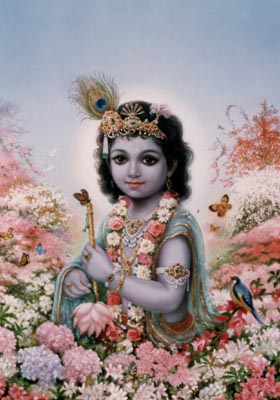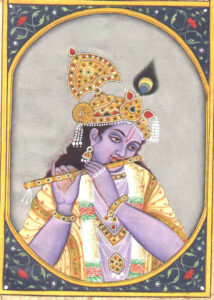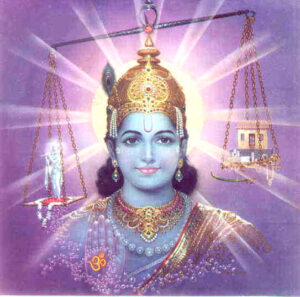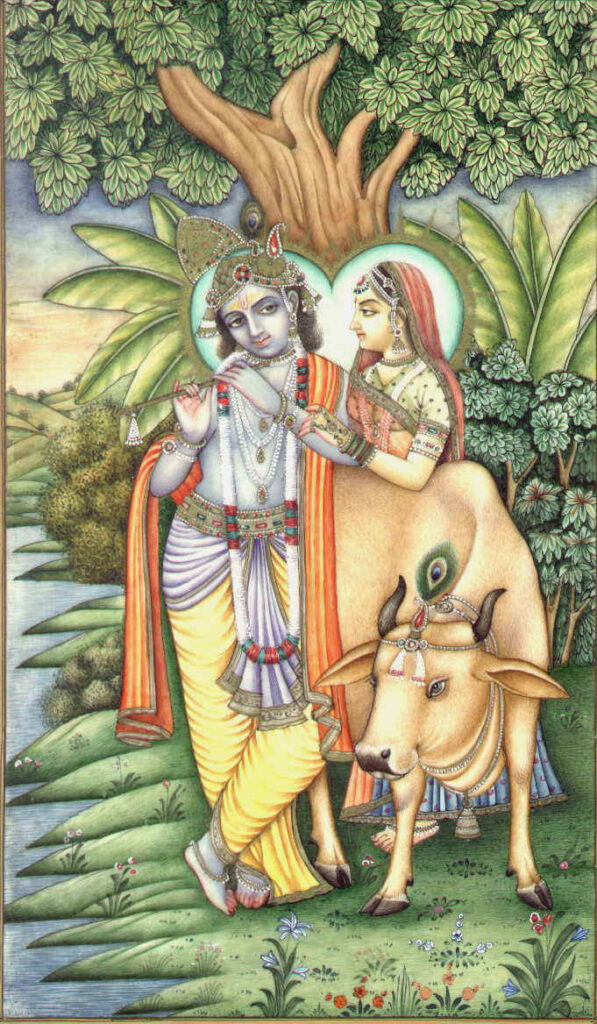Krishna Appears on Earth 5,252 Years Ago–Today
SPIRITUALITY, 26 Aug 2024
Stephen Knapp (Sri Nandanandana dasa) – TRANSCEND Media Service
26 Aug 2024 Sri Krishna Janmastami (appearance: 3,228 BC): Why Lord Krishna Descends into This World
Why the Lord descends into this world is for multiple purposes, but primarily for two reasons. One of which is that, since He originally enunciated the ancient religious path of the Vedas for the benefit of the whole universe, whenever that becomes obstructed by the demoniac or wicked atheists, He descends in one of His forms, which is in the transcendental mode of goodness. Thus, He again establishes the righteous Vedic path. He is the same Supreme Person, and in His incarnation as Krishna appeared in the home of Vasudeva with His plenary portion, Balarama. This was for the second reason, which is to relieve the earth of the burden of the demoniac. As Krishna, He came to kill the hundreds of armies led by the kings who were but expansions of the enemies of the demigods, and to spread the fame of the Yadu dynasty. (Bhag.10.48.23-24)
Sri Krishna Himself explains this in the Bhagavad-gita: “Although I am unborn and My transcendental body never deteriorates, and although I am the Lord of all sentient beings, I still appear in every millennium in My original transcendental form. Whenever and wherever there is a decline in religious practices, O son of Bharata, and a predominant rise of irreligion–at that time I descend Myself. In order to deliver the pious and to annihilate the miscreants, as well as to reestablish the principles of religion, I advent Myself millennium after millennium. One who knows the transcendental nature of My appearance and activities does not, upon leaving the body, take his birth again in this material world, but attains My eternal abode, O Arjuna.” (Bg. 4.4-9)
Arjuna, after understanding the position of Lord Krishna, recognized His superior position and said, “Thus You descend as an incarnation to remove the burden of the world and to benefit Your friends, especially those who are Your exclusive devotees and are rapt in meditation upon You.” (Bhag.1.7.25)
The sages at Kuruksetra, while addressing Lord Krishna, also summarized the reason for Lord Krishna’s appearance in this world. They explained that at suitable times He assumes the mode of pure goodness to protect His devotees and punish the wicked. Thus, the Supreme Personality descends to maintain the eternal path of the Vedas by enjoying His pleasure pastimes. (Bhag.10.84.18)
It is also described that when the Lord assumes a humanlike body, it is to show His mercy to His devotees. Then He engages in the sort of pastimes that will attract those who hear about them. Then they may become dedicated to Him. (Bhag.10.33.36) These pastimes of the Lord are so powerful that they can remove the sins of the three planetary systems and deliver those who are trapped in the continuous cycle of birth and death. (Bhag.10.86.34) Those who desire to serve the Lord should hear of these activities. Hearing such narrations of these pastimes destroy the reactions to fruitive work [karma]. (Bhag.10.90.49)
It is by Lord Krishna’s pastimes that He calls all the conditioned souls to Him through love. Thus, by His wondrous activities He attracts all beings to return to their natural, spiritual position by reawakening their dormant love and service to Him, the Supreme Being. This is the purpose of human life, which provides the best facility and intellect for understanding our spiritual identity and connection with the Lord. As Sukadeva Gosvami explained to Maharaja Pariksit, “He, the Personality of Godhead, as the maintainer of all in the universe, appears in different incarnations after establishing the creation, and thus He reclaims all kinds of conditioned souls amongst the humans, nonhumans and demigods.” (Bhag.2.10.42)
“To show causeless mercy to the devotees who would take birth in the future of this age of Kali, the Supreme Personality of Godhead, Krishna, acted in such a way that simply by remembering Him one will be freed from all the lamentation and unhappiness of material existence.” (Bhag.9.24.61) However, Lord Krishna also explains that when He descends in His human form, the fools who are ignorant of His spiritual nature and supreme dominion over everything deride and criticize Him (Bg.9.11)
Nonetheless, Lord Krishna Himself further explains the reasons for His appearance in this world to King Muchukunda: “My dear friend, I have taken thousands of births, lived thousands of lives and accepted thousands of names. In fact My births, activities and names are limitless, and thus even I cannot count them. After many lifetimes someone might count the dust particles on the earth, but no one can ever finish counting My qualities, activities, names and births. O King, the greatest sages enumerate My births and activities, which take place throughout the three phases of time, but never do they reach the end of them. Nonetheless, O friend, I will tell you about My current birth, name and activities. Kindly hear. Some time ago, Lord Brahma requested Me to protect religious principles and destroy the demons who were burdening the earth. Thus I descended in the Yadu dynasty, in the home of Anakadundubhi. Indeed, because I am the son of Vasudeva, people call Me Vasudeva.” (Bhag.10.51.36-40)
How Lord Krishna Took Birth in the Material World
The Supreme Being in His form as Sri Krishna appeared on this planet 5,000 years ago and performed His pastimes for 125 years before returning to His spiritual abode. The Vishnu Purana (Book Four, Chapter Twenty-four) establishes that the age of Kali-yuga began when Lord Krishna left this world in 3102 BC. There are many stories in the Vedic literature which narrate how Krishna engages in loving activities with His friends and relatives when He appears in this world, and how He performs amazing feats which thrill and astonish everyone, both while on this planet and in His spiritual abode. However, He brings His spiritual domain and His numerous pure devotees with Him when He descends into this world. Descriptions of the many activities and pastimes which go on in the spiritual world are found in such texts as Srimad-Bhagavatam, Vishnu Purana, Mahabharata, Caitanya-caritamrta, and Sanatana Goswami’s Brihat Bhagavatamritam, and others, which explain the many levels and unlimited nature of the spiritual realm. Indeed, the body of the Lord is described as full of eternal bliss, truth, knowledge, the most dazzling splendour, and source of all that exists.
It is described that when the Lord appeared on this planet in the nineteenth and twentieth incarnations, He advented Himself as Lord Balarama and Lord Krishna in the family of Vrishni [the Yadu dynasty], and by so doing He removed the burden of the world. (Bhag.1.3.23)
The story of Lord Krishna’s birth is a unique narrative, as told in the Tenth Canto of Srimad-Bhagavatam. About 5,000 years ago when the earth was overburdened by the military might of the demoniac who had taken the forms of rulers and kings, the spirit of mother earth took the shape of a cow and approached Lord Brahma to seek relief. Concerned with the situation on earth, Lord Brahma, Lord Shiva and other demigods went to the shore of the ocean of milk. Within that ocean is an island which is the residence of Lord Vishnu. After mentally offering prayers to Lord Vishnu, Brahma could understand the advice the Lord gave him. This was that He would soon appear on the surface of the earth in order to mitigate the burden of the demoniac kings. Therefore, the demigods and their wives should appear in the Yadu dynasty in order to serve as servants of Lord Krishna and increase the size of that dynasty.
Then one day Vasudeva, Krishna’s father, and his wife, Devaki, were riding home from their wedding. Devaki’s brother, the demoniac King Kamsa, was driving the chariot. Then a voice of warning came from the sky announcing that Kamsa would be killed by Devaki’s eighth son. Kamsa was immediately ready to kill his sister, but Vasudeva instructed him and talked him out of the idea. Kamsa was still not satisfied, so Vasudeva said he would bring all of the children to Kamsa as they were born. Then Kamsa could kill them. As the children were born, at first Kamsa decided not to kill them. But later Kamsa learned from the sage Narada Muni that the demigods were appearing in the Yadu and Vrishni dynasties and were conspiring to kill him. Kamsa then decided that all the children in these families should be killed, and that Vasudev and Devaki should be imprisoned in his jail in Mathura, and that their children should not be spared. Narada Muni had also told Kamsa that in his previous life he had been a demon named Kalanemi who was killed by Lord Vishnu. Thus, Kamsa became especially infuriated and a dedicated enemy of all the descendants of the Yadu dynasty.
Anantadeva (Balarama) first appeared in the womb of Devaki as her seventh pregnancy. It was Yogamaya, Krishna’s internal potency, who made the arrangement to transfer Anantadeva from the womb of Devaki to that of Rohini, a wife of Nanda Maharaja in Gokul, from whom He appeared as Balarama. Then, with the prayers and meditations of Vasudeva, Lord Krishna appeared within his heart, and then within the heart of Devaki. So Devaki’s eighth pregnancy was Krishna Himself. Thereafter, she became increasingly effulgent, which drew the attention of Kamsa, who wanted to kill Krishna. Thus, he became absorbed in thoughts of Krishna. Devaki also drew the attention of the many demigods who came to offer prayers to her and the Lord in her womb.
When the Lord appeared, He first exhibited His four-armed form to show that He was the Supreme Lord. Vasudeva and Devaki were struck with wonder and offered many prayers. Yet, fearing Kamsa, Devaki prayed that Krishna withdraw His four-armed form and exhibit His two-armed form.
The Lord also told them of how He had appeared two other times as their son in the form of Prishnigarbha and Vamanadeva. This was the third time that He was appearing as their son to fulfill their desires. That night, during a rainstorm, Lord Krishna desired to leave the prison and be taken to Gokul. By the arrangement of Yogamaya, the shackles and prison doors were opened and Vasudeva was able to leave the prison and take Krishna to Gokul, thus saving the child from the danger of Kamsa. At this time, Yogamaya herself had taken birth from Mother Yashoda as a baby girl. When Vasudeva arrived at Nanda Maharaja’s house, everyone was in deep sleep. Thus, he was able to place Lord Krishna in the hands of Yashoda, while taking her own newly born baby girl back with him. This baby girl was actually Krishna’s energy, Yogamaya. When he returned, he placed the baby girl on Devaki’s bed, and prepared to accept his place in the prison again by putting the shackles back on. Later, when Yashoda awoke in Gokul, she could not remember whether she had given birth to a male or female child, and easily accepted Lord Krishna as her own.
When the baby girl, Yogamaya, began crying in the morning, it drew the attention of the doorkeepers of the prison, who then notified King Kamsa. Kamsa forcefully appeared in the prison to kill the child. Devaki pleaded with him to save the baby. Instead, he grabbed the little girl from her arms and tried to dash the baby against a rock. However, she slipped from his hands and rose above his head, floating in the air while exhibiting her true form as the eight-armed Durga. Durga told Kamsa that the person for whom he was looking had already taken birth elsewhere. Thus, Kamsa became filled with wonder that Devaki’s eighth child appeared to be a female, and the enemy he feared had taken birth elsewhere. Then he released Devaki and Vasudeva, being apologetic for all that he had done. Yet, after conferring with his ministers, they decided that they had best try to kill all the children that had been born in the past ten days in the attempt to try to find and kill Kamsa’s enemy, Krishna. Thus started the atrocities of Kamsa and his ministers, which he would eventually pay for when Lord Krishna would kill him. Meanwhile, Lord Krishna started His pastimes with His devotees in Gokul and Vrindavana to display His unique characteristics, personality and beauty.
In this way, as Sri Uddhava explained to Vidura, “The Lord appeared in the mortal world by His external potency, yogamaya. He came in His eternal form, which is just suitable for His pastimes. These pastimes were wonderful for everyone, even for those proud of their own opulence, including the Lord Himself in His form as the Lord of Vaikuntha. Thus His [Sri Krishna’s] transcendental body is the ornament of all ornaments… The Personality of Godhead, the all-compassionate controller of both the material and spiritual creations, is unborn, but when there is friction between His peaceful devotees and persons who are in the material modes of nature, He takes His birth just like fire, accompanied by the mahat-tattva.” (Bhag. 3.2.12, 15)
Janmastami–Krishna’s Birth Festival
The day of Krishna’s birth in this world is called Janmastami. It is one of the biggest of the annual Vedic festivals. It is held in the typical pattern of preparation, purification, realization, and then celebration. On the day of the festival, people will fast and spend the day focused on Krishna, meditating and chanting the Hare Krishna mantra and other prayers or songs devoted to Lord Krishna. Often times, there will also be plays and enactments of the birth and pastimes of the Lord. Thus, offering their obeisances and focusing their minds on Lord Krishna, the devotees hold themselves in such single-pointed concentration throughout the day. This, along with the fasting, indicates the overcoming of the false ego and the attachment to the body. After relieving ourselves of such hindrances, we engage in the worship of the Lord as the evening brings us closer to the occasion of His divine appearance. Therein, after a full day of purification, the Supreme appears and we realize our own connection with the Lord, who then manifests as the ultimate worshipable object of our purified consciousness. Then at the stroke of midnight Lord Krishna takes birth, which is commemorated by a midnight arati ceremony. Thus, this climax at night represents our overcoming the darkness of ignorance and reaching the state of purified spiritual knowledge and perception. Therein we overcome the influence of the mind and senses and enter the state of steady awareness wherein there is full spiritual awakening. If one can follow this process, then he or she can experience the real meaning of Krishna Janmastami.
The Beauty of Krishna
Lord Krishna’s beauty is described in numerous prayers, poems, and portions of the Vedic literature. So we could provide many verses that describe this aspect of Krishna. An example of this is found when Lord Brahma relates Lord Krishna’s form in the many verses of his Brahma-samhita. He also explains the beauty of Lord Krishna in his prayers that he directly offered to the Lord in the Bhagavatam. He says that Lord Krishna’s body is dark blue like a new cloud. His garments are like brilliant lightning, and the beauty of Krishna’s face is enhanced by His earrings and the peacock feather He wears on His head. He stands beautifully while wearing garlands made from the forest flowers, carrying a herding stick, a buffalo horn, and a flute. (Bhag.10.14.1)
His personal form is so attractive that it is considered the reservoir of all beauty. In fact, all beautiful things emanate from Him. His form is so attractive that it directs one’s attention away from all other objects. Those same objects then seem devoid of attractiveness after seeing Lord Krishna. Thus, He attracts the minds of all people. His words also captivated the minds of all who remembered them. Even seeing His footsteps, people were attracted. Thus, Krishna spreads His glories which are sung everywhere throughout the universe in the most sublime and essential Vedic verses. Lord Krishna says that by hearing and chanting about His glorious pastimes, the conditioned souls within this world could cross the ocean of ignorance. (Bhag.11.1.7)
The attractive nature of God is further described in the Caitanya-caritamrita (Madhya-lila, 17.139-140): “The transcendental qualities of Sri Krishna are completely blissful and relishable. Consequently Lord Krishna’s qualities attract even the minds of self-realized persons from the bliss of self-realization. Those who are self-satisfied and unattracted by external material desires are also attracted to the loving service of Sri Krishna, whose qualities are transcendental and whose activities are wonderful. Hari, the Personality of Godhead, is called Krishna because He has such transcendentally attractive features.”
Many of the Gosvamis of Vrindavana who had personally realized the attractive features of the Supreme wrote many books about the transcendental personality of God. One of the greatest of these saints was Rupa Gosvami (1489-1564 A.D.) who wrote a list of Krishna’s characteristics in his book, Bhakti rasamrita-sindhu. This list describes 64 different qualities of God that are mentioned in the Vedic literature. This again confirms that the Lord is not merely an impersonal force, but a person who interacts in every way with the creation and the living entities that are within the creation that manifests from Him.
The list includes the following qualities: 1) beautiful features of the entire body; 2) marked with all auspicious characteristics; 3) extremely pleasing; 4) effulgent; 5) strong; 6) ever youthful; 7) wonderful linguist; 8) truthful; 9) talks pleasingly; 10) fluent; 11) highly learned; 12) highly intelligent; 13) a genius; 14) artistic; 15) extremely clever; 16) expert; 17) grateful; 18) firmly determined; 19) an expert judge of time and circumstances; 20) sees and speaks on the authority of the scriptures–the Veda; 21) pure; 22) self-controlled; 23) steadfast; 24) forbearing; 25) forgiving; 26) grave; 27) self-satisfied; 28) possessing equilibrium; 29) magnanimous; 30) religious; 31) heroic; 32) compassionate; 33) respectful; 34) gentle; 35) liberal; 36) shy; 37) protector of surrendered souls; 38) happy; 39) well-wisher of devotees; 40) controlled by love; 41) all-auspicious; 42) most powerful; 43) all-famous; 44) popular; 45) partial to devotees; 46) very attractive to all women; 47) all-worshipable; 48) all-opulent; 49) all-honorable; and 50) the Supreme controller.
These fifty qualities, however, may also be found in varying degrees in some of the jivas or common living entities in this universe. But they are found in Lord Krishna to an unlimited degree. But besides these 50 qualities, there are five more which may also be manifested at times in the forms of Lord Brahma and Shiva. These are: 51) changeless; 52) all-cognizant; 53) ever-fresh; 54) sat-cid-ananda-vigraha–possessing a transcendental form of eternity, full of knowledge and absolute bliss; and 55) possessing all mystic perfection.
Beyond the above mentioned qualities, which may be seen in other forms of Divinity such as the demigods, Lord Krishna has the following exceptional qualities which are also manifested in the form of Narayana or Vishnu, His form as the Lord of Vaikuntha. These are: 56) inconceivable potency; 57) uncountable universes are generated from His body; 58) the original source of all incarnations; 59) the giver of salvation to the enemies He kills; and 60) the attractor of liberated souls.
Besides the above-mentioned traits, Lord Krishna has four more qualities that are found only in Him, and not even in His forms of Vishnu, not to mention any of the demigods. These are: 61) the performer of wonderful pastimes (especially his childhood pastimes); 62) surrounded by devotees endowed with unsurpassed love of Godhead; 63) the attractor of all living entities in all universes through the expert playing of His flute; and 64) possessor of unexcelled beauty without rival. All of these qualities are those of someone who has a highly developed form and personality.
Even the Bible verifies that God has a most beautiful form and is not formless, as is shown in the next few verses that are very similar to the Vedic description of God’s form: “My beloved is white and ruddy, the chiefest among ten thousand. His head is as the most fine gold, his locks are bushy, and black as a raven. His eyes are as the eyes of doves by the rivers of waters, washed with milk, and fitly set. His cheeks are as a bed of spices, as sweet flowers; his lips like lilies, dropping sweet smelling myrrh. His hands are as gold rings set with the beryl; his belly is as bright ivory overlaid with sapphires. His legs are as pillars of marble, set upon sockets of fine gold; his countenance is as Lebanon, excellent as the cedars. His mouth is most sweet; yea, he is altogether lovely. This is my beloved, and this is my friend.” (Song of Solomon 5.10-16)
Obviously, there is no more elevated truth or higher bliss than the personal form of the Supreme. As Sri Krishna says: “O conqueror of wealth [Arjuna], there is no truth superior to Me.” (Bg.7.7) Many great transcendental scholars have accepted this fact, including Ramanujacharya, Madhvacharya, Vallabhacharya, Sri Chaitanya Mahaprabhu, Baladeva, as well as Lord Brahma, who, after performing many austerities for spiritual purification, became perfectly self-realized and, getting a glimpse of the Lord’s spiritual nature, composed the Brahma-samhita many thousands of years ago and described what were his confidential realizations. One such verse is the following: “Krishna, who is known as Govinda, is the Supreme Personality of Godhead. He has an eternal blissful spiritual body. He is the origin and He is the prime cause of all causes.” (Brahma-samhita 5.1)
__________________________________________________
 Stephen Knapp (Sri Nandanandana dasa) has dedicated himself to spreading the deepest and most practical levels of spiritual knowledge about the soul–our real identity. Though this world may give us numerous challenges, when we rise above the basic materialistic view and its limited search for solutions, our evolutionary development on all levels greatly accelerates. By recognizing that we are all spiritual beings who are, basically, attempting to achieve the same essentials for our existence–namely love, acceptance, harmony, peace, and happiness, not to mention the ordinary needs of food, water, clothing and shelter–we can reach a new level of cooperation with each other. Stephen has written many books on this and related subjects and studied with A. C. Bhaktivedanta Swami Prabhupada becoming initiated into the spiritual line of Brahma-Madhava-Gaudiya sampradaya. He is also president of the Vedic Friends Association. srinandan@aol.com
Stephen Knapp (Sri Nandanandana dasa) has dedicated himself to spreading the deepest and most practical levels of spiritual knowledge about the soul–our real identity. Though this world may give us numerous challenges, when we rise above the basic materialistic view and its limited search for solutions, our evolutionary development on all levels greatly accelerates. By recognizing that we are all spiritual beings who are, basically, attempting to achieve the same essentials for our existence–namely love, acceptance, harmony, peace, and happiness, not to mention the ordinary needs of food, water, clothing and shelter–we can reach a new level of cooperation with each other. Stephen has written many books on this and related subjects and studied with A. C. Bhaktivedanta Swami Prabhupada becoming initiated into the spiritual line of Brahma-Madhava-Gaudiya sampradaya. He is also president of the Vedic Friends Association. srinandan@aol.com
Go to Original – stephen-knapp.com
Tags: God, Hinduism, India, Krishna, Krishna Consciousness, Krishna Janmastami, Religion, Spiritual Science, Spirituality, Vedas, Vedic Culture, Vedic Science, Vedic literature
DISCLAIMER: The statements, views and opinions expressed in pieces republished here are solely those of the authors and do not necessarily represent those of TMS. In accordance with title 17 U.S.C. section 107, this material is distributed without profit to those who have expressed a prior interest in receiving the included information for research and educational purposes. TMS has no affiliation whatsoever with the originator of this article nor is TMS endorsed or sponsored by the originator. “GO TO ORIGINAL” links are provided as a convenience to our readers and allow for verification of authenticity. However, as originating pages are often updated by their originating host sites, the versions posted may not match the versions our readers view when clicking the “GO TO ORIGINAL” links. This site contains copyrighted material the use of which has not always been specifically authorized by the copyright owner. We are making such material available in our efforts to advance understanding of environmental, political, human rights, economic, democracy, scientific, and social justice issues, etc. We believe this constitutes a ‘fair use’ of any such copyrighted material as provided for in section 107 of the US Copyright Law. In accordance with Title 17 U.S.C. Section 107, the material on this site is distributed without profit to those who have expressed a prior interest in receiving the included information for research and educational purposes. For more information go to: http://www.law.cornell.edu/uscode/17/107.shtml. If you wish to use copyrighted material from this site for purposes of your own that go beyond ‘fair use’, you must obtain permission from the copyright owner.
Join the discussion!
We welcome debate and dissent, but personal — ad hominem — attacks (on authors, other users or any individual), abuse and defamatory language will not be tolerated. Nor will we tolerate attempts to deliberately disrupt discussions. We aim to maintain an inviting space to focus on intelligent interactions and debates.



